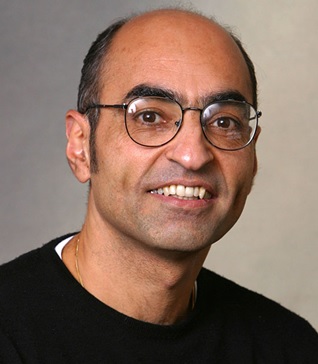
What do you teach?…
In the last few years, my teaching assignments have been mainly upper-division undergraduate courses: EC 310 (Econometrics); EC 319 (Intermediate Microeconomics); EC 440 (International Economics); and two foundation graduate courses: Bus 500 (Business Statistics); and Bus 501(Economic Analysis).
My educational philosophy is to teach students to think critically, to continuously learn, and adapt to the dynamic world we are facing. My objectives are (1) to teach state-of-the-art content, (2) to offer relevant real-world context for the content, and (3) to add new skill sets to existing ones. Hopefully students come out of my courses with a foundation solid enough for continuous learning.
Economic Analysis (BUS 501) and Statistics and Quantitative Methods (BUS 500) classes draw heavily from my scholarly work. For instance, every paper that I have written brings in economic theory and a heavy dose of empirical work based on data analysis, econometrics, and statistics.
Why Should students take your courses?

I was once an MBA student. We had study groups for commiserating and solving cases in marketing, strategic management, problems in finance, economics, accounting, operations research, etc. I realized that many of my classmates who came from different educational backgrounds, typical to MBA programs, struggled in designing solutions for problems at hand. Some didn’t even know where to start or where to plug in the multiple moving pieces or variables to achieve a solution. That memory stuck with me. In my MBA classes, one of my hopes is for students to develop skills as architects able to design solutions for these complex problems. Hopefully, they will take these skills to their future careers! I’d say about 80 percent are quite comfortable with problem solving by the end of the semester.
We live in a data-driven world. All my graduate and undergraduate course require data analysis. The pandemic offered an unfortunate context for my courses. For instance, I teach international trade and economics. We saw firsthand what happens when international supply chains get disrupted.
Sampling and statistical tests played a huge role in developing and deploying the COVID vaccines. One of my optional readings for BUS 500 is a book entitled “The Lady Tasting Tea How Statistics Revolutionized Science in the 20th Century.” It narrates the role of statistics in sciences and many walks of life.

Despite the advent of artificial intelligence, as we saw in the vaccine development, the classical statistical sampling was still the methodology applied to establish vaccine efficacy. So, in my opinion, statistics is here to stay for the foreseeable future. Our course shines a light on the applications of statistics in all areas of business practice from management to production, quality control, marketing, and finance. MBA students work on technical report assignments that are designed to train them to explain the results of various statistical tests in a nontechnical narrative. I emphasize how MBA students, especially those planning on entering new carrier paths, can benefit from complementing their Excel skills with the knowledge of Python and SQL, among others. As an example, one of my undergraduate students, well versed in data analytics, recently completed his MBA and started working for Amazon as a Senior Product Manager.
The economic analysis course (BUS 501) shows MBA students how the free market economy is designed to provide goods and services efficiently. It also explains the role of the central bank (the Fed), and the government in a market economy. This class is hands-on, data oriented, and Excel-based.

When the pandemic hit, the US economy was humming on all cylinders and experiencing its lowest unemployment levels in over six decades. Suddenly, there were lock downs, the unemployment rate jumped from around 3.5 percent to close to 20 percent. The Fed and the Treasury sprang into action to stave off a protracted recession. The Fed purchased government and other bonds and pumped trillions of dollars into the economy. The stimulus checks were the fiscal policy tool that complemented the monetary infusion. We discuss these policies and the rationale behind them in BUS 501. There is not a day that Forbes, Bloomberg, Jerome Powell (Fed Chair) or Janet Yellen (Treasury Secretary) are not commenting on some aspect of economic policy, inflation, monetary policy, and the like. These policies impact everyone’s lives and businesses. MBA students need to understand these discussions and the ramifications of various outcomes.
Aside from this extraordinary situation, I think anyone who works and votes, should probably have a course in economics. Just understanding the supply and demand for goods, services, labor, and wages and price determination in the market are important. For instance, it becomes clear that prices and wages are based on market forces and can only change when the underlying demand and supply conditions change. Tools of economic theory show how interfering with final prices and wages in an arbitrary manner, without structurally addressing supply and demand, can result in undesirable and unintended outcomes. As voters, a basic understanding of economics may help us make more informed decisions when casting our ballots.
What are you working on?
Research is a crucial complementary function to teaching. I find scholarly research exciting and refreshing. It strengthens my teaching in several ways. For instance, it allows me to stay current and apply the most recent data, literature, and methodologies in my lectures. I follow but do not regurgitate the textbook that everyone is able to read. Furthermore, as a University, we pride ourselves for being a premier teaching school which requires that we stay on the cutting edge of our fields to deliver on this promise.
I’ve had the following recent publications in prestigious academic journals:
Dynamics of the Crude Oil Price Volatility and Major Latin American Equity Markets: A Study in Time and Frequency Domains. Bulletin of Economic Research. August 2020. (With A. Chatrath, J. Macri, and K. Raffiee). https://doi.org/10.1111/boer.12258
Oil Price Pass through to Agricultural Commodities, American Journal of Agricultural Economics. April 2020. https://doi.org/10.1002/ajae.12088. (with Clark Lundberg, Tristan Skolrud, and Arjun Chatrath)
Socioeconomic Determinants of Drug Abuse in the United States. Journal of Social Economics Research, 8(1), 39-49, 2021. (with Anderson, M. (class of 2020), & Raffiee, K. )
Currently I’m working on the following papers: One examines the airline industry and the long-run effects of deregulation that started in the late 1970s. Our paper analyzes the industry performance in a highly competitive environment. This paper is a joint research with Evan Hamilton, economics major, class of 2020.
A second paper analyzes the metrics set by the United Nations (UN) as Sustainable Development Goals (SDG) and their association with the Gross Domestic Product (GDP) in emerging economies. This research uses a panel data to estimate a regression model that shows the association of SDGs with GDP. The paper concludes that targeting the GDP may not be consistent with achieving SDGs. This is a joint work with Lauren Kerr, economics major, class of 2020. Both papers are in final stages and will be submitted to the Journal of transportation Economics, and Journal of Human Development, respectively.
The third research paper is a joint work with professor Arjun Chatrath and a colleague from the University of Nevada, Reno, College of Business. This paper tests the reaction of short- and long-term volatilities in S&P 500 to uncertainties in economic policies, investor sentiment, and the Chicago Board of Trade volatility index (CBOT VIX). We’ll present it at the Annual Conference of the Western Economic Association International (WEAI) on June 30th, 2021.
What do you like to do for fun?

I enjoy cycling, walking, racquetball, and skiing. During the pandemic, I have walked a lot and managed to cross country ski a few days, which was fun! I’m hoping to get back to playing racquetball again, which I used to three times a week! Haven’t been on a court for about a year and a half. Hope I’ll remember which end of the racquet to hold!